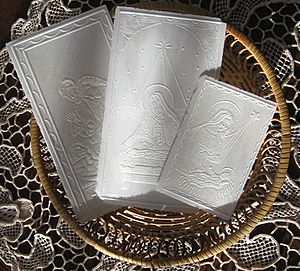Christmas wafer facts for kids

wafer
|
|
| Type | Flatbread |
|---|---|
| Place of origin | Poland |
| Region or state | Central Europe, Baltic States |
| Main ingredients | Wheat flour, water |
The Christmas wafer is a special Christmas tradition. It is celebrated by Catholics in countries like Poland, Lithuania, and Slovakia. In Poland, it's called opłatek (plural opłatki). In Lithuania, it's kalėdaitis (plural kalėdaičiai). In Slovakia, it's oblátka (plural oblátky).
This custom usually happens on December 24, which is Christmas Eve. In Lithuania, it's part of the Kūčios meal. In Poland, it's part of the Wigilia meal.
These wafers are very thin, flat breads. They are made from pure wheat flour and water. They are usually shaped like rectangles. They are similar to the bread used in church services. The wafers often have religious pictures pressed into them. These pictures can show the nativity scene, Virgin Mary with baby Jesus, or the Star of Bethlehem.
Contents
Sharing the Christmas Wafer
Sharing the Christmas wafer is a beautiful tradition. It happens right before the Christmas Eve meal.
Families gather around the table. The oldest person in the family holds a large wafer. They break off a small piece to start the ritual. Then, they pass the wafer to the next person. As they do this, they say a prayer or a wish for their loved ones. This continues until everyone at the table has a piece of the wafer.
Finally, each family member shares good wishes with everyone else. They break off a piece from the other person's wafer. Then they eat it. This shows love and unity.
History and Meaning
The tradition of breaking the Christmas wafer started in Poland. It began around the 10th century. People of Polish background all over the world still practice it. Many people see it as one of the oldest and most loved Polish traditions.
Wafer's Symbols
The Christmas wafer stands for family unity. Many believe the family is the most important part of society. This tradition shows that family members should be close. It also symbolizes forgiveness and making up after disagreements.
In Poland and some parts of Central Europe, these wafers are sometimes colored. They are used as decorations. People also send them in greeting cards to family and friends who live far away.
Christmas Wafer in Lithuania
In Lithuania, the Christmas wafer is called kalėdaitis. It's also known by other names like plotkelė or paplotėlis. Families share it before their Kūčios meal.
Lithuanian Wafer Ritual
A plate with wafers is placed in the middle of the table. There is one wafer for each person at the meal. The head of the family, usually the oldest person, takes a wafer. They offer it to a family member. They wish them a Happy Christmas. The family member responds, "God grant that we are all together again next year." Then they break off a piece of the wafer.
After that, the family member offers a piece of their wafer back to the head of the family. The head of the family then offers their wafer to every other person at the table.
Exchanging Wishes
After the head of the family, everyone at the table exchanges greetings. They also exchange small pieces of wafer. It's important not to miss anyone. Missing someone is thought to bring bad luck. When breaking a piece, some people try to get a bigger piece. This is believed to mean their year will be better. The person holding the wafer tries to prevent a large piece from being taken. This is thought to "break their luck."
Once everyone has exchanged wafers, family members bring their pieces to the head of the house. The head of the house looks at the wafers. They might tell a "fortune" based on how the wafers are arranged. After this, everyone returns to their seats and eats their wafers.
Where the Tradition Came From
This tradition has very old roots. It goes back to the early days of Christianity. It is seen as a special way to prepare for the Eucharist. The Eucharist is a holy part of church services. It uses unleavened bread, which is bread made without yeast.
The "opłatek" as a Christmas custom started in Poland. It became very popular by the 17th century. It was a part of the culture of Polish nobles, called szlachta. The custom spread throughout the Polish-Lithuanian Commonwealth and nearby countries.
In the 19th century, Poland was divided by other countries. During this time, sharing the "opłatek" gained a new meaning. People would wish for Poland to become independent again. Since then, "opłatki" often have religious pictures on them. In the 20th century, the "opłatek" custom grew even more. It became a way for co-workers or students to meet and share wishes.

